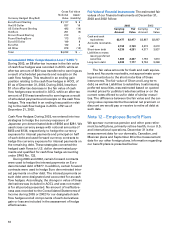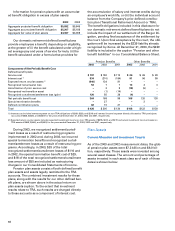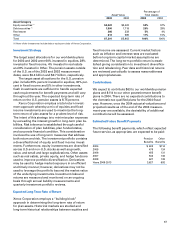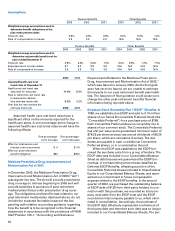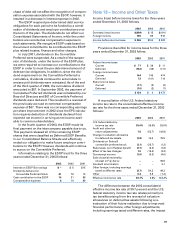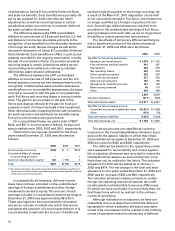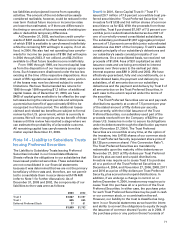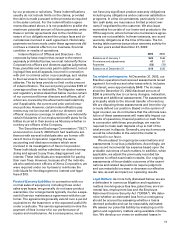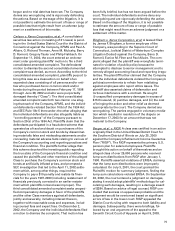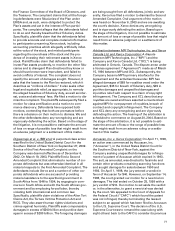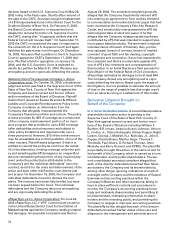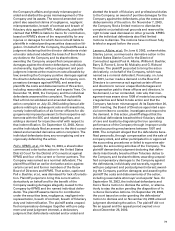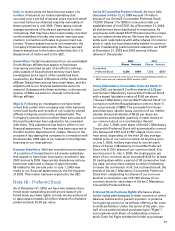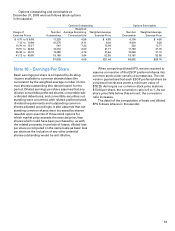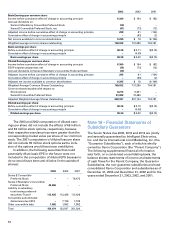Xerox 2003 Annual Report Download - page 76
Download and view the complete annual report
Please find page 76 of the 2003 Xerox annual report below. You can navigate through the pages in the report by either clicking on the pages listed below, or by using the keyword search tool below to find specific information within the annual report.
74
consultation with outside counsel handling our
defense in these matters, which involves an analysis
of potential results, assuming a combination of litiga-
tion and settlement strategies. Should developments
in any of these matters cause a change in our determi-
nation as to an unfavorable outcome and result in the
need to recognize a material accrual, or should any of
these matters result in a final adverse judgment or be
settled for significant amounts, they could have a
material adverse effect on our results of operations,
cash flows and financial position in the period or peri-
ods in which such change in determination, judgment
or settlement occurs.
Litigation Against the Company:
In re Xerox Corporation Securities Litigation: A consol-
idated securities law action (consisting of 17 cases) is
pending in the United States District Court for the
District of Connecticut. Defendants are the Company,
Barry Romeril, Paul Allaire and G. Richard Thoman.
The consolidated action purports to be a class action
on behalf of the named plaintiffs and all other pur-
chasers of common stock of the Company during the
period between October 22, 1998 through October 7,
1999 (“Class Period”). The amended consolidated
complaint in the action alleges that in violation of
Section 10(b) and/or 20(a) of the Securities Exchange
Act of 1934, as amended (“1934 Act”), and SEC Rule
10b-5 thereunder, each of the defendants is liable as a
participant in a fraudulent scheme and course of busi-
ness that operated as a fraud or deceit on purchasers
of the Company’s common stock during the Class
Period by disseminating materially false and mislead-
ing statements and/or concealing material facts relat-
ing to the defendants’ alleged failure to disclose the
material negative impact that the April 1998 restructur-
ing had on the Company’s operations and revenues.
The amended complaint further alleges that the
alleged scheme: (i) deceived the investing public
regarding the economic capabilities, sales proficien-
cies, growth, operations and the intrinsic value of the
Company’s common stock; (ii) allowed several corpo-
rate insiders, such as the named individual defen-
dants, to sell shares of privately held common stock of
the Company while in possession of materially
adverse, non-public information; and (iii) caused the
individual plaintiffs and the other members of the pur-
ported class to purchase common stock of the
Company at inflated prices. The amended consolidat-
ed complaint seeks unspecified compensatory dam-
ages in favor of the plaintiffs and the other members
of the purported class against all defendants, jointly
and severally, for all damages sustained as a result of
defendants’ alleged wrongdoing, including interest
thereon, together with reasonable costs and expenses
incurred in the action, including counsel fees and
expert fees. On September 28, 2001, the court denied
the defendants’ motion for dismissal of the complaint.
On November 5, 2001, the defendants answered the
complaint. On or about January 7, 2003, the plaintiffs
filed a motion for class certification. That motion has
not yet been fully briefed or argued before the court.
The parties are currently engaged in discovery. The
individual defendants and we deny any wrongdoing
and are vigorously defending the action. Based on the
stage of the litigation, it is not possible to estimate the
amount of loss or range of possible loss that might
result from an adverse judgment or a settlement of
this matter.
Christine Abarca, et al. v. City of Pomona, et al.
(Pomona Water Cases): On June 24, 1999, the
Company was served with a summons and complaint
filed in the Superior Court of the State of California for
the County of Los Angeles. The complaint was filed on
behalf of 681 individual plaintiffs claiming damages as
a result of our alleged disposal and/or release of haz-
ardous substances into the soil and groundwater.
Subsequently, six additional complaints were filed in
the same court on behalf of another 459 plaintiffs, with
the same claims for damages as the June 1999 action.
All seven cases have been served on the Company.
Currently there are approximately 1,050 plaintiffs, as
certain plaintiffs have been dismissed from the litiga-
tion. Plaintiffs in all seven cases allege that hazardous
substances from the Company’s operations entered
the municipal drinking water supplied by the City of
Pomona and the Southern California Water Company,
and as a result they were exposed to the substances
by inhalation, ingestion and dermal contact. Plaintiffs’
claims against the Company include personal injury,
wrongful death, property damage, negligence, tres-
pass, nuisance, and violation of the California Unfair
Trade Practices Act. Damages are unspecified. The
seven cases against the Company (“Abarca Group”)
have been coordinated with approximately 13 unrelat-
ed cases against other defendants which involve
alleged contaminated groundwater and drinking water
in the San Gabriel Valley area of Los Angeles County.
In all of those cases, plaintiffs have sued both the
providers of drinking water and the industrial defen-
dants who they contend contaminated the water. The
body of groundwater involved in the Abarca cases,
and allegedly contaminated by the Company, is sepa-
rate and distinct from the body of groundwater that is
involved in the San Gabriel Valley cases, and there is
no allegation that the Company is involved in the San
Gabriel Valley cases. Nonetheless, the court ordered
both groups of cases to be coordinated because both
groups concern allegations of groundwater and drink-
ing water contamination, have similar theories of lia-
bility alleged against the defendants, and involve a
number of similar legal issues, thus apparently mak-
ing it more efficient, in the view of the court, for all of
them to be handled by one judge. Discovery has


